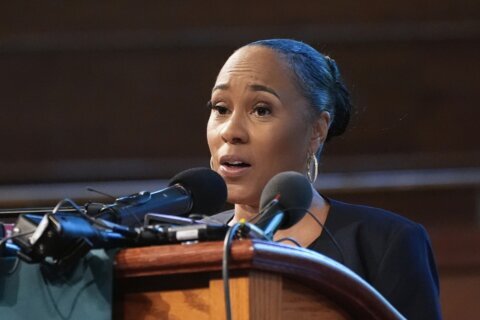Few people ultimately opted out of the $600 million class action settlement Norfolk Southern offered to people affected by last year’s disastrous East Palestine train derailment despite the questions residents raised about the deal, lawyers said.
The plaintiffs’ attorneys said only 22 of the nearly 2,000 households in the small Ohio town where the derailment happened in February 2023 opted out of the deal before the July 1 deadline. In total, only 173 of the more than 190,000 households in the 20-mile (32.2-kilometer) area around the derailment covered by the deal had decided not to accept it as of Monday’s filing.
The train crash spilled an assortment of hazardous chemicals from tank cars that ruptured, and days after the derailment, officials decided to blow open five tank cars and burn the vinyl chloride inside because they worried the cars might explode. The National Transportation Safety Board has said that vent and burn procedure was likely unnecessary but the officials who made that call didn’t have all the information they needed.
A federal judge has given the deal preliminary approval, but a hearing will be held in late September to determine if the deal should go through. Separately, Norfolk Southern agreed to pay a $15 million fine and make changes to its operation as part of a federal settlement.
The lawyers said in a statement Tuesday that “the community’s response to the settlement has been overwhelmingly positive” and thousands of claims have already been submitted.
A handful of residents filed formal objections to the deal because they believe it’s not fair that some of the people who were most affected by the derailment might wind up with the smallest settlements and that people didn’t have enough time or information to decide whether this deal is fair.
Residents had a chance to hear the NTSB discuss the reasons why the train derailed and the communication failures afterward at the board’s June 25 hearing, but the agency didn’t release its final report until Friday — nearly two weeks after people who live near East Palestine had to decide whether to accept the settlement. And the lawyers haven’t yet filed the detailed test results and other evidence they gathered as part of the lawsuit.
Some residents might receive little or nothing from the settlement because the final amount they get will be reduced by how much assistance they took from Norfolk Southern since the derailment. Even households near the derailment that are supposed to get roughly $70,000 could wind up with nothing if the railroad put them up in pricey hotels or rental homes for months.
One of the leading critics of the deal, Jami Wallace, said people like her who lost their homes and experienced illnesses after the derailment shouldn’t be denied compensation.
“Getting nothing for suffering and intentional poisoning is not fair or adequate,” Wallace said in her formal objection.
Norfolk Southern provided more than $21 million in direct assistance to families who had to temporarily relocate after the derailment.
The lawyers who negotiated the deal with the railroad have said that kind of offset procedure is customary in any lawsuit, so residents would likely face that even if they pursued their own lawsuits against Norfolk Southern.
The amount people are supposed to receive from the settlement also varies based on how close they lived to the derailment and how it affected them. Documents filed in court suggests that a family living within 2 miles (3.2 kilometers) of the derailment might receive $70,000 for property damage. Someone who lived farther away will get considerably less — maybe only $250 for families more than 15 miles (24 kilometers) away.
The lawyers have said some people could receive more than those estimated amounts after a claims administrator reviews all the individual factors.
Resident Tamara Lynn Freeze said in a handwritten note to the judge that it’s unfair to make her decide whether to accept the settlement before she even knows exactly how much she might receive from it.
The settlement offers payments of $10,000 for injuries, but accepting that would mean that residents won’t be able to sue the railroad down the road if they develop cancer or other serious health conditions. They don’t have to accept the personal injury payment to get the money for property damage.
Many people are still reporting respiratory problems, unexplained rashes and other symptoms more than a year after the derailment while others have no health complaints. And residents worry about the potential long-term health implications of all the chemicals they have been exposed to.
The court wouldn’t allow the settlement to include anything for potential future health costs because those aren’t known yet, the lawyers say.
The plaintiffs’ attorneys are expected to share up to $162 million in legal fees out of the settlement if the judge approves.
Copyright © 2024 The Associated Press. All rights reserved. This material may not be published, broadcast, written or redistributed.







